GIS-Based Agricultural Land Use Favorability Assessment in the Context of Climate Change: A Case Study of the Apuseni Mountains
Abstract
:1. Introduction
2. Methodology and Database
2.1. Study Area
2.2. Database
- FI—Favorability index;
- Sslope—scoring value for slope;
- Stemp—scoring value for average annual temperature;
- SPP—scoring value for average annual precipitation;
- SG—scoring value for soil gleiss;
- SPS—scoring value for pseudogleiss;
- Stext—scoring value for soil texture;
- Svol—scoring value for soil edaphic value;
- SR—scoring value for soil reaction.
3. Results and Discussion
4. Conclusions
Author Contributions
Funding
Institutional Review Board Statement
Informed Consent Statement
Data Availability Statement
Conflicts of Interest
References
- Kalnay, E.; Cai, M. Impact of urbanization and land-use change on climate. Nature 2003, 423, 528–531. [Google Scholar] [PubMed]
- Foley, J.A.; Defries, R.; Asner, G.P.; Barford, C.; Bonan, G.; Carpenter, S.R.; Chapin, F.S.; Coe, M.T.; Daily, G.C.; Gibbs, H.K.; et al. Global consequences of land use. Science 2005, 309, 570–574. [Google Scholar]
- Yahaya, I.; Xu, R.; Zhou, J.; Jiang, S.; Su, B.; Huang, J.; Cheng, J.; Dong, Z.; Jiang, T. Projected patterns of land uses in Africa under a warming climate. Sci. Rep. 2024, 14, 12315. [Google Scholar] [CrossRef]
- Patriche, C.V.; Irimia, L.M. Mapping the impact of recent climate change on viticultural potential in Romania. Theor. Appl. Climatol. 2022, 148, 1035–1056. [Google Scholar]
- Prăvălie, R.; Peptenatu, D.; Sirodoev, I. The impact of climate change on the dynamics of agricultural systems in south-western Romania. Carpathian J. Earth Environ. Sci. 2013, 8, 175–186. [Google Scholar]
- Prăvălie, R.; Sîrodoev, I.; Nita, I.A.; Patriche, C.; Dumitraşcu, M.; Roşca, B.; Tişcovschi, A.; Bandoc, G.; Săvulescu, I.; Mănoiu, V.; et al. NDVI-based ecological dynamics of forest vegetation and its relationship to climate change in Romania during 1987–2018. Ecol. Indic. 2022, 136, 108629. [Google Scholar]
- Adams, R.M.; Hurd, B.H.; Lenhart, S.; Leary, N. Effects of global climate change on agriculture: An interpretative review. Clim. Res. 1998, 11, 19–30. [Google Scholar]
- Howden, S.M.; Soussana, J.F.; Tubiello, F.N.; Chhetri, N.; Dunlop, M.; Meinke, H. Adapting agriculture to climate change. Proc. Natl. Acad. Sci. USA 2007, 104, 19691–19696. [Google Scholar] [PubMed]
- Malhi, G.S.; Kaur, M.; Kaushik, P. Impact of climate change on agriculture and its mitigation strategies: A review. Sustainability 2021, 13, 1318. [Google Scholar] [CrossRef]
- Agovino, M.; Casaccia, M.; Ciommi, M.; Ferrara, M.; Marchesano, K. Agriculture, climate change and sustainability: The case of EU-28. Ecol. Indic. 2019, 105, 525–543. [Google Scholar]
- Zoran, M.A.; Zoran, L.F.V.; Dida, A.I. Forest vegetation dynamics and its response to climate changes. In Remote Sensing for Agriculture, Ecosystems, and Hydrology XVIII; SPIE: St Bellingham, WA, USA, 2016; Volume 9998, pp. 598–608. [Google Scholar]
- Mihai, G.; Alexandru, A.M.; Nita, I.A.; Birsan, M.V. Climate change in the provenance regions of Romania over the last 70 years: Implications for forest management. Forests 2022, 13, 1203. [Google Scholar] [CrossRef]
- Stringer, L.C.; Scrieciu, S.S.; Reed, M.S. Biodiversity, land degradation, and climate change: Participatory planning in Romania. Appl. Geogr. 2009, 29, 77–90. [Google Scholar]
- Rusu, T.; Moraru, P.I.; Coste, C.; Cacovean, H.; Chețan, F.; Chețan, C. Impact of climate change on climatic indicators in Transylvanian Plain, Romania. J. Food Agric. Environ. 2014, 12, 469–473. [Google Scholar]
- Li, C.; de Jong, R.; Schmid, B.; Wulf, H.; Schaepman, M.E. Spatial variation of human infuences on grassland biomass on the Qinghai-Tibetan plateau. Sci. Total Environ. 2019, 665, 678–689. [Google Scholar]
- Rusu, T.; Moraru, P.I. Impact of climate change on crop land and technological recommendations for the main crops in Transylvanian Plain, Romania. Rom. Agric. Res. 2015, 32, 103–111. [Google Scholar]
- Cheval, S.; Dumitrescu, A.; Adamescu, M.; Cazacu, C. Identifying climate change hotspots relevant for ecosystems in Romania. Clim. Res. 2020, 80, 165–173. [Google Scholar]
- Hurtt, G.C.; Chini, L.; Sahajpal, R.; Frolking, S.; Bodirsky, B.L.; Calvin, K.; Doelman, J.C.; Fisk, J.; Fujimori, S.; Goldewijk, K.K.; et al. Harmonization of global land use change and management for the period 850–2100 (LUH2) for CMIP6. Geosci. Model Dev. 2020, 13, 5425–5464. [Google Scholar]
- Cheval, S.; Bulai, A.; Croitoru, A.E.; Dorondel, Ș.; Micu, D.; Mihăilă, D.; Sfîcă, L.; Tișcovschi, A. Climate change perception in Romania. Theor. Appl. Climatol. 2022, 149, 253–272. [Google Scholar] [PubMed]
- Necula, C.; Rossing, W.A.; Easdale, M.H. Archetypes of climate change adaptation among large-scale arable farmers in southern Romania. Agron. Sustain. Dev. 2024, 44, 1–18. [Google Scholar]
- Mahmood, R.; Pielke, R.A.; Hubbard, K.G.; Niyogi, D.; Bonan, G.; Lawrence, P.; McNider, R.; McAlpine, C.; Etter, A.; Gameda, S.; et al. Impacts of land use/land cover change on climate and future research priorities. Bull. Am. Meteorol. Soc. 2010, 91, 37–46. [Google Scholar]
- Prăvălie, R.; Sîrodoev, I.; Patriche, C.; Roșca, B.; Piticar, A.; Bandoc, G.; Sfîcă, L.; Tişcovschi, A.; Dumitraşcu, M.; Chifiriuc, C.; et al. The impact of climate change on agricultural productivity in Romania. A country-scale assessment based on the relationship between climatic water balance and maize yields in recent decades. Agric. Syst. 2020, 179, 102767. [Google Scholar]
- Gunderson, C.A.; O’hara, K.H.; Campion, C.M.; Walker, A.V.; Edwards, N.T. Thermal plasticity of photosynthesis: The role of acclimation in forest responses to a warming climate. Glob. Chang. Biol. 2010, 16, 2272–2286. [Google Scholar]
- Tkemaladze, G.S.; Makhashvili, K.A. Climate changes and photosynthesis. Ann. Agrar. Sci. 2016, 14, 119–126. [Google Scholar]
- Reich, P.B.; Sendall, K.M.; Stefanski, A.; Rich, R.L.; Hobbie, S.E.; Montgomery, R.A. Effects of climate warming on photosynthesis in boreal tree species depend on soil moisture. Nature 2018, 562, 263–267. [Google Scholar]
- Haokip, S.W.; Shankar, K.; Lalrinngheta, J. Climate change and its impact on fruit crops. J. Pharmacogn. Phytochem. 2020, 9, 435–438. [Google Scholar]
- Deryng, D.; Conway, D.; Ramankutty, N.; Price, J.; Warren, R. Global crop yield response to extreme heat stress under multiple climate change futures. Environ. Res. Lett. 2014, 9, 034011. [Google Scholar]
- Sun, Q.; Miao, C.; Hanel, M.; Borthwick, A.G.; Duan, Q.; Ji, D.; Li, H. Global heat stress on health, wildfires, and agricultural crops under different levels of climate warming. Environ. Int. 2019, 128, 125–136. [Google Scholar]
- Zhao, C.; Piao, S.; Wang, X.; Huang, Y.; Ciais, P.; Elliott, J.; Huang, M.; Janssens, I.A.; Li, T.; Lian, X.; et al. Plausible rice yield losses under future climate warming. Nat. Plants 2016, 3, 16202. [Google Scholar]
- Benlloch-González, M.; Sánchez-Lucas, R.; Bejaoui, M.A.; Benlloch, M.; Fernández-Escobar, R. Global warming effects on yield and fruit maturation of olive trees growing under field conditions. Sci. Hortic. 2019, 249, 162–167. [Google Scholar]
- Kaiser, H.M.; Riha, S.J.; Wilks, D.S.; Rossiter, D.G.; Sampath, R. A farm-level analysis of economic and agronomic impacts of gradual climate warming. Am. J. Agric. Econ. 1993, 75, 387–398. [Google Scholar]
- Toromade, A.S.; Soyombo, D.A.; Kupa, E.; Ijomah, T.I. Reviewing the impact of climate change on global food security: Challenges and solutions. Int. J. Appl. Res. Soc. Sci. 2024, 6, 1403–1416. [Google Scholar]
- Shaver, G.R.; Canadell, J.; Chapin, F.S.; Gurevitch, J.; Harte, J.; Henry, G.; Ineson, P.; Jonasson, S.; Melillo, J.; Pitelka, L.; et al. Global Warming and Terrestrial Ecosystems: A Conceptual Framework for Analysis: Ecosystem responses to global warming will be complex and varied. Ecosystem warming experiments hold great potential for providing insights on ways terrestrial ecosystems will respond to upcoming decades of climate change. Documentation of initial conditions provides the context for understanding and predicting ecosystem responses. Bioscience 2000, 50, 871–882. [Google Scholar]
- Magyari-Sáska, Z.; Magyari-Sáska, A. Changes and Trends in Ideal Holiday Period Based On Holiday Climate Index Applied To The Carpathian Basin. Geogr. Tech. 2023, 18, 225–237. [Google Scholar]
- Traill, L.W.; Lim, M.L.; Sodhi, N.S.; Bradshaw, C.J. Mechanisms driving change: Altered species interactions and ecosystem function through global warming. J. Anim. Ecol. 2010, 79, 937–947. [Google Scholar]
- Saxe, H.; Cannell, M.G.; Johnsen, Ø.; Ryan, M.G.; Vourlitis, G. Tree and forest functioning in response to global warming. New Phytol. 2001, 149, 369–399. [Google Scholar]
- Haarsma, R.J.; Hazeleger, W.; Severijns, C.; de Vries, H.; Sterl, A.; Bintanja, R.; Jan van Oldenborgh, G.; van den Brink, H.W. More hurricanes to hit western Europe due to global warming. Geophys. Res. Lett. 2013, 40, 1783–1788. [Google Scholar]
- Vautard, R.; Gobiet, A.; Sobolowski, S.; Kjellström, E.; Stegehuis, A.; Watkiss, P.; Mendlik, T.; Landgren, O.; Nikulin, G.; Teichmann, C.; et al. The European climate under a 2 C global warming. Environ. Res. Lett. 2014, 9, 034006. [Google Scholar]
- Lehmann, J.; Coumou, D.; Frieler, K. Increased record-breaking precipitation events under global warming. Clim. Chang. 2015, 132, 501–515. [Google Scholar]
- Roudier, P.; Andersson, J.; Donnelly, C.; Feyen, L.; Greuell, W.; Ludwig, F. Projections of future floods and hydrological droughts in Europe under a+ 2 C global warming. Clim. Chang. 2016, 135, 341–355. [Google Scholar]
- Magyari-Sáska, Z.; Croitoru, A.E.; Horváth, C.; Dombay, Ș. ClimShift–A new toolbox for the detection of climate change. Geosci. Data J. 2023, in press. [Google Scholar] [CrossRef]
- Piticar, A.; Andrei, S.; Tudor, A. Spatiotemporal Variability of Convective Events in Romania Based on METAR Data. Sustainability 2024, 16, 3243. [Google Scholar] [CrossRef]
- Uber, M.; Haller, M.; Brendel, C.; Hillebrand, G.; Hoffmann, T. Past, present and future rainfall erosivity in central Europe based on convection-permitting climate simulations. Hydrol. Earth Syst. Sci. 2024, 28, 87–102. [Google Scholar]
- Ochoa, C.; Bar-Massada, A.; Chuvieco, E. A European-scale analysis reveals the complex roles of anthropogenic and climatic factors in driving the initiation of large wildfires. Sci. Total Environ. 2024, 917, 170443. [Google Scholar] [PubMed]
- Bratu, I.A.; Câmpu, V.R.; Budău, R.; Stanciu, M.A.; Enescu, C.M. Subsidies for Forest Environment and Climate: A Viable Solution for Forest Conservation in Romania? Forests 2024, 15, 1533. [Google Scholar] [CrossRef]
- Tudoran, G.M. Composition of Natural Forest Types—Long-Term Goals for Sustainable Forest Management. Forests 2024, 15, 1196. [Google Scholar] [CrossRef]
- Felton, A.; Belyazid, S.; Eggers, J.; Nordström, E.M.; Öhman, K. Climate change adaptation and mitigation strategies for production forests: Trade-offs, synergies, and uncertainties in biodiversity and ecosystem services delivery in Northern Europe. Ambio 2024, 53, 1–16. [Google Scholar]
- Ignjačević, P.; Botzen, W.; Estrada, F.; Daanen, H.; Lupi, V. Climate-induced mortality projections in Europe: Estimation and valuation of heat-related deaths. Int. J. Disaster Risk Reduct. 2024, 111, 104692. [Google Scholar]
- Urban, M.C.; Swaegers, J.; Stoks, R.; Snook, R.R.; Otto, S.P.; Noble, D.W.A.; Moiron, M.; Hällfors, M.H.; Gómez-Llano, M.; Fior, S.; et al. When and how can we predict adaptive responses to climate change? Evol. Lett. 2024, 8, 172–187. [Google Scholar]
- Pearman, P.B.; Broennimann, O.; Aavik, T.; Albayrak, T.; Alves, P.C.; Aravanopoulos, F.A.; Bertola, L.D.; Biedrzycka, A.; Buzan, E.; Cubric-Curik, V.; et al. Monitoring of species’ genetic diversity in Europe varies greatly and overlooks potential climate change impacts. Nat. Ecol. Evol. 2024, 8, 267–281. [Google Scholar]
- Viñals, E.; Maneja, R.; Rufí-Salís, M.; Martí, M.; Puy, N. Reviewing social-ecological resilience for agroforestry systems under climate change conditions. Sci. Total Environ. 2023, 869, 161763. [Google Scholar]
- Benitez-Alfonso, Y.; Soanes, B.K.; Zimba, S.; Sinanaj, B.; German, L.; Sharma, V.; Bohra, A.; Kolesnikova, A.; Dunn, J.A.; Martin, A.C.; et al. Enhancing climate change resilience in agricultural crops. Curr. Biol. 2023, 33, R1246–R1261. [Google Scholar] [PubMed]
- Lin, B.B. Resilience in agriculture through crop diversification: Adaptive management for environmental change. BioScience 2011, 61, 183–193. [Google Scholar]
- Qiao, L.; Wang, X.; Smith, P.; Fan, J.; Lu, Y.; Emmett, B.; Li, R.; Dorling, S.; Chen, H.; Liu, S.; et al. Soil quality both increases crop production and improves resilience to climate change. Nat. Clim. Change 2022, 12, 574–580. [Google Scholar]
- IPCC. Climate Change 2022: Impacts, Adaptation, and Vulnerability. In Contribution of Working Group II to the Sixth Assessment Report of the Intergovernmental Panel on Climate Change; Cambridge University Press: Cambridge, UK, 2022. [Google Scholar]
- Bielecka, E. GIS spatial analysis modeling for land use change. A bibliometric analysis of the intellectual base and trends. Geosciences 2020, 10, 421. [Google Scholar] [CrossRef]
- Romano, G.; Dal Sasso, P.; Trisorio Liuzzi, G.; Gentile, F. Multi-Criteria Decision Analysis for Land Suitability Mapping in a Rural Area of Southern Italy. Land Use Policy 2015, 48, 131–143. [Google Scholar]
- Montgomery, B.; Dragićević, S. Comparison of GIS-Based Logic Scoring of Preference and Multicriteria Evaluation Methods: Urban Land Use Suitability. Geogr. Anal. 2016, 48, 427–447. [Google Scholar]
- Prăvălie, R.; Niculiţă, M.; Roşca, B.; Patriche, C.; Dumitraşcu, M.; Marin, G.; Nita, I.-A.; Bandoc, G. Modelling forest biomass dynamics in relation to climate change in Romania using complex data and machine learning algorithms. Stoch. Environ. Res. Risk Assess. 2023, 37, 1669–1695. [Google Scholar]
- Irimia, L.M.; Patriche, C.V.; Quenol, H.; Sfîcă, L.; Foss, C. Shifts in climate suitability for wine production as a result of climate change in a temperate climate wine region of Romania. Theor. Appl. Climatol. 2018, 131, 1069–1081. [Google Scholar]
- Brandolini, F.; Compostella, C.; Pelfini, M.; Turner, S. The Evolution of Historic Agroforestry Landscape in the Northern Apennines (Italy) and Its Consequences for Slope Geomorphic Processes. Land 2023, 12, 1054. [Google Scholar] [CrossRef]
- Fathian, F.; Prasad, A.D.; Dehghan, Z.; Eslamian, S. Influence of land use/land cover change on land surface temperature using RS and GIS techniques. Int. J. Hydrol. Sci. Technol. 2015, 5, 195–207. [Google Scholar]
- Galacho-Jiménez, F.B.; Quesada-Molina, P.; Carruana-Herrera, D.; Reyes-Corredera, S. Application of the Analysis Time Series and Multispectral Images for the Estimation of the Conditions of the Vegetation Covers of the Natural Areas of Southern Spain. Land. 2023, 12, 42. [Google Scholar] [CrossRef]
- Roșca, S.M.; Bilaşco, S.; Păcurar, I.; Marcel Oncu Negruşier, C.; Petrea, D. Land capability classification for crop and fruit product assessment using GIS technology. Case study: The Niraj River Basin (Transylvania Depression, Romania). Not. Bot. Horti Agrobot. Cluj-Napoca 2015, 43, 235–242. [Google Scholar]
- Zhao, L.Q.; van Duynhoven, A.; Dragićević, S. Machine Learning for Criteria Weighting in GIS-Based Multi-Criteria Evaluation: A Case Study of Urban Suitability Analysis. Land 2024, 13, 1288. [Google Scholar] [CrossRef]
- Bilaşco, Ş.; Roşca, S.; Păcurar, I.; Moldovan, N.; Amalia, B.O.Ţ.; Negrușier, C.; Sestras, P.; Bondrea, M.; Sanda, N.A.Ș. Identification of land suitability for agricultural use by applying morphometric and risk parameters based on GIS spatial analysis. Not. Bot. Horti Agrobot. Cluj-Napoca 2016, 44, 302–312. [Google Scholar]
- Ioan, M. Evaluation of Suitability for Different Agricultural Crops Based on Soil Improvement with an Emphasis on the Influence of Soil Pollution in the Someșului Mic Area, Cluj-Napoca—Dej Sector. Ph.D. Thesis, USAMV Cluj Napoca, Cluj-Napoca, Romania, 2021. [Google Scholar]
- Nath, I.B.; Ramey, V.A.; Klenow, P.J. How much Will Global Warming Cool Global Growth? (No. w32761); National Bureau of Economic Research: Cambridge, MA, USA, 2024. [Google Scholar]
- Folini, D.; Friedl, A.; Kübler, F.; Scheidegger, S. The climate in climate economics. Rev. Econ. Stud. 2024, rdae011. [Google Scholar] [CrossRef]
- Sarathamani, T.; Leelavathi, B. A Comprehensive Guide to Economic and Environmental Impact of Global Ice Warming and the Role of Artificial Intelligence in Fighting Climate Change. Educ. Adm. Theory Pract. 2024, 30, 879–886. [Google Scholar]
- Junaid, M.D.; Gokce, A.F. Global agricultural losses and their causes. Bull. Biol. Allied Sci. Res. 2024, 2024, 66. [Google Scholar]
- Soil Map of Romania, 1:200000; ICPA Bucharest: Bucharest, Romania, 2017.
- European Union—European Environment Agency (EEA). CLC 2012—Copernicus Land Monitoring Service. Corine Land Cover (CLC). 2012. Available online: https://land.copernicus.eu/pan-european/corine-land-cover/clc-2012/view (accessed on 3 February 2024).
- Hansen, M.C.; Potapov, P.V.; Moore, R.; Hancher, M.; Turubanova, S.A.; Tyukavina, A.; Thau, D.; Stehman, S.V.; Goetz, S.J.; Loveland, T.R.; et al. High-resolution global maps of 21st-century forest cover change. Science 2013, 342, 850–853. [Google Scholar]
- European Settlement Map. ESM 2012—Release 2016. Copernicus Land Monitoring Service. 2016. Available online: https://land.copernicus.eu/pan-european/GHSL/european-settlement-map/EU%20GHSL%202014?tab=metadata (accessed on 18 March 2024).
- OSM. Open Street Map. Geofabrik Download Server. 2017. Available online: https://download.geofabrik.de/ (accessed on 1 April 2024).
- The Climate Change Knowledge Portal (CCKP). Available online: https://climateknowledgeportal.worldbank.org (accessed on 4 June 2024).
- Clavero, M.; Villero, D.; Brotons, L. Climate change or land use dynamics: Do we know what climate change indicators indicate? PLoS ONE 2011, 6, e18581. [Google Scholar]
- Order 212/2002 Technical Norms. Part I Credit Rating of Agricultural Lands and Their Classification into Quality Classes. Available online: https://lege5.ro/Gratuit/gqytamru/partea-i-bonitarea-terenurilor-agricole-si-incadrarea-in-clase-de-calitate-a-acestora-norma-tehnica?dp=gizdknbwgyzdq (accessed on 2 March 2024).
- Păcurar, I.; Mihai, B. Pedology and the Certification of Agricultural Lands; Risoprint Publishing House: Cluj Napoca, Romania, 2015. [Google Scholar]
- Rosca, S. Bazinul Nirajului studiu de Geomorfologie aplicata; Risoprint Editorial House: Berlin, Germany, 2015. [Google Scholar]
- Matei, I.; Pacurar, I.; Rosca, S.; Bilasco, S.; Sestras, P.; Rusu, T.; Jude, E.T.; Tăut, F.D. Land Use Favourability Assessment Based on Soil Characteristics and Anthropic Pollution. Case Study Somesul Mic Valley Corridor, Romania. Agronomy 2020, 10, 1245. [Google Scholar] [CrossRef]
- Akpoti, K.; Kabo-bah, A.T.; Zwart, S.J. Agricultural land suitability analysis: State-of-the-art and outlooks for integration of climate change analysis. Agric. Syst. 2019, 173, 172–208. [Google Scholar]
- Bagherzadeh, A.; Ghadiri, E.; Souhani Darban, A.R.; Gholizadeh, A. Land suitability modeling by parametric-based neural networks and fuzzy methods for soybean production in a semi-arid region. Model. Earth Syst. Environ. 2016, 2, 104. [Google Scholar]
- Bonfante, A.; Langella, G.; Mercogliano, P.; Bucchignani, E.; Manna, P.; Terribile, F. Science of the Total Environment A dynamic viticultural zoning to explore the resilience of terroir concept under climate change. Sci. Total Environ. 2018, 624, 294–308. [Google Scholar] [CrossRef] [PubMed]
- Liambila, R.N.; Kibret, K. Climate change impact on land suitability for rainfed crop production in Lake Haramaya Watershed, Eastern Ethiopia. J. Earth Sci. Clim. Chang. 2016, 7, 1–12. [Google Scholar]
- Ranjitkar, S.; Sujakhu, N.M.; Merz, J.; Kindt, R.; Xu, J.; Matin, M.A.; Ali, M.; Zomer, R.J. Suitability analysis and projected climate change impact on banana and coffee production zones in Nepal. PLoS ONE 2016, 11, e0163916. [Google Scholar]
- Mas, J.-F.; Soares Filho, B.; Pontius, R.G.; Farfán Gutiérrez, M.; Rodrigues, H. A Suite of Tools for ROC Analysis of Spatial Models. ISPRS Int. J. Geo-Inf. 2013, 2, 869–887. [Google Scholar] [CrossRef]
- Sestras, P.; Mircea, S.; Cîmpeanu, S.M.; Teodorescu, R.; Roșca, S.; Bilașco, Ș.; Rusu, T.; Salagean, T.; Dragomir, L.O.; Marković, R.; et al. Soil Erosion Assessment Using the Intensity of Erosion and Outflow Model by Estimating Sediment Yield: Case Study in River Basins with Different Characteristics from Cluj County, Romania. Appl. Sci. 2023, 13, 9481. [Google Scholar] [CrossRef]
- Dolean, B.-E.; Bilașco, Ș.; Petrea, D.; Moldovan, C.; Vescan, I.; Roșca, S.; Fodorean, I. Evaluation of the Built-Up Area Dynamics in the First Ring of Cluj-Napoca Metropolitan Area, Romania by Semi-Automatic GIS Analysis of Landsat Satellite Images. Appl. Sci. 2020, 10, 7722. [Google Scholar] [CrossRef]


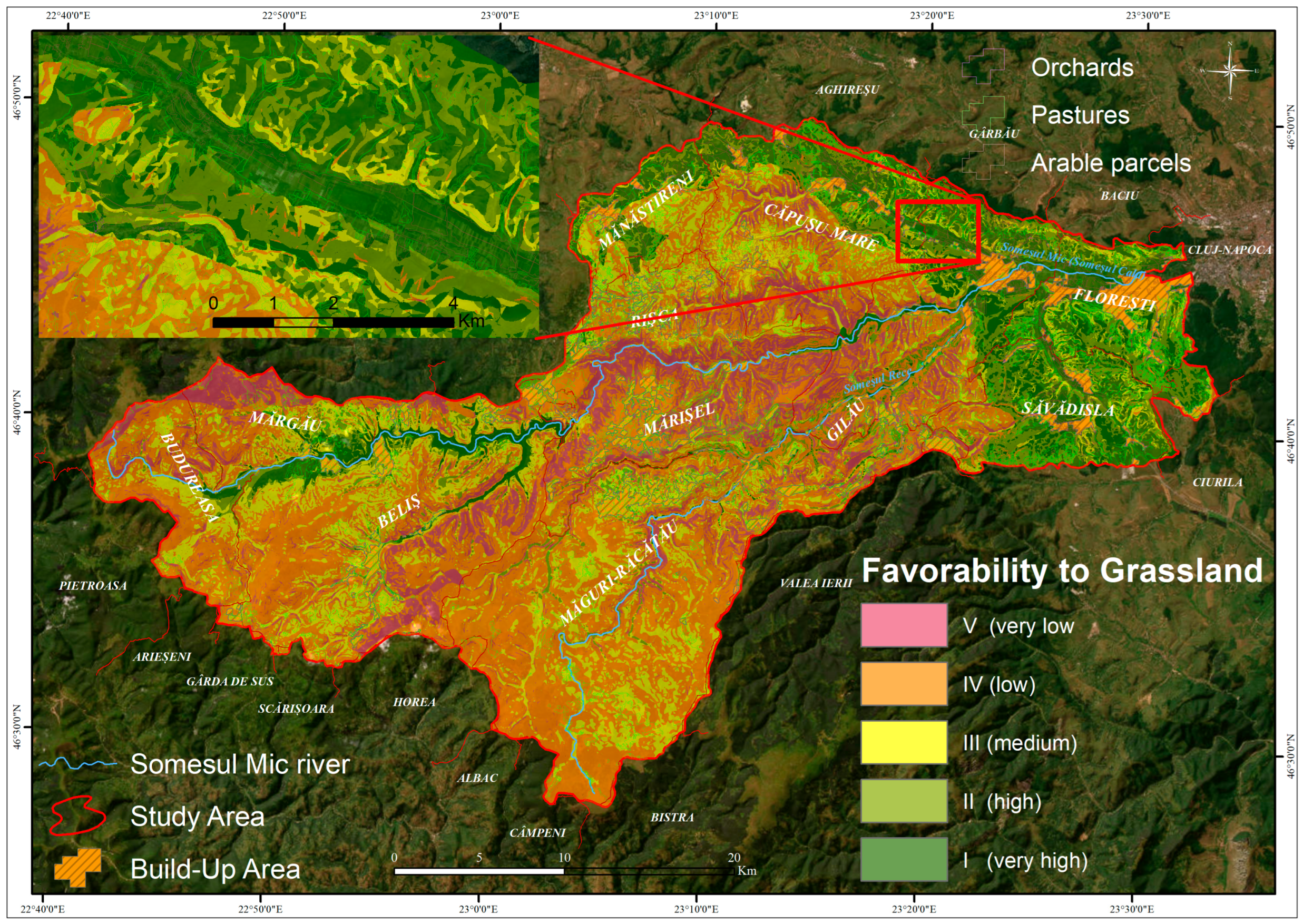

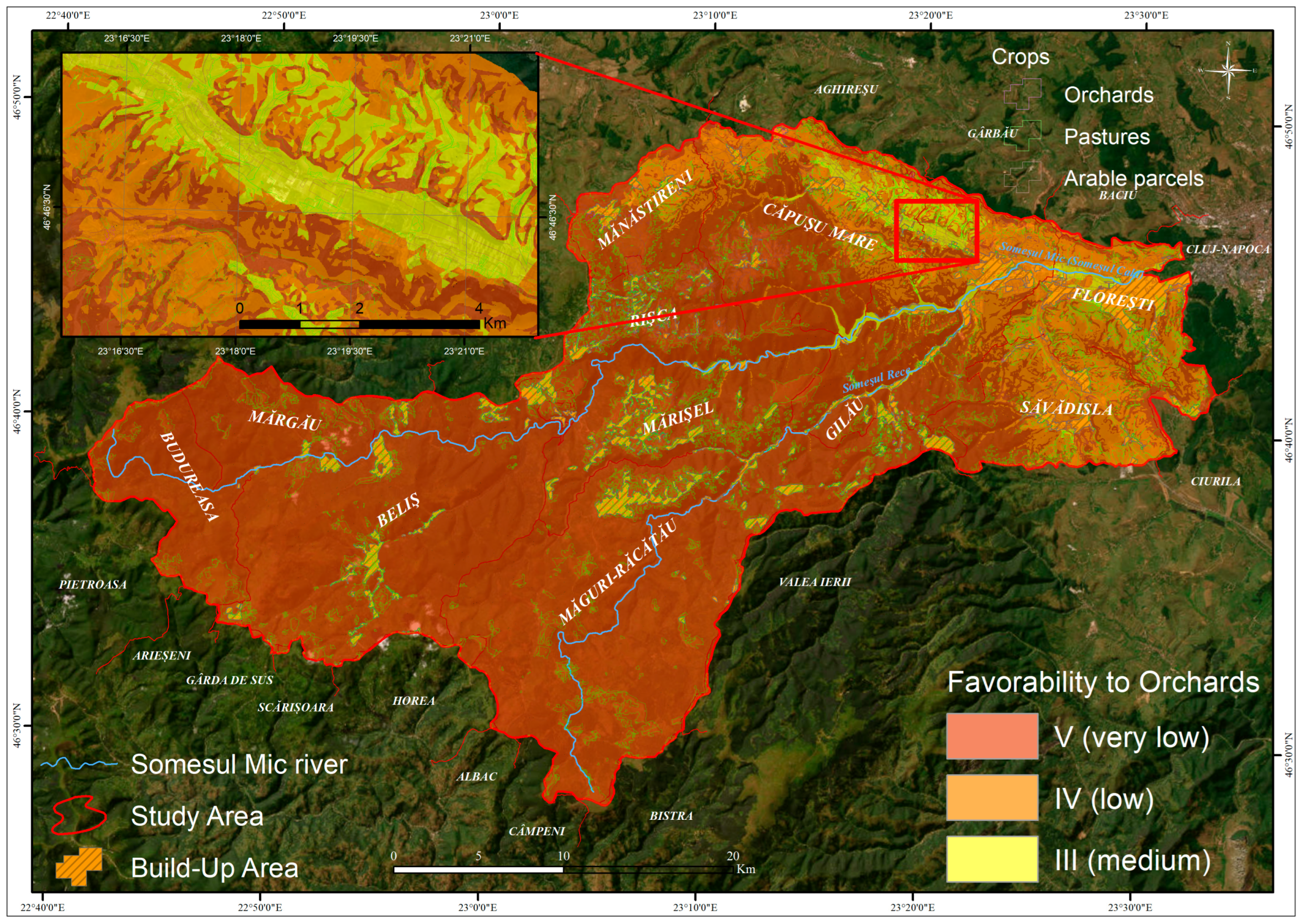




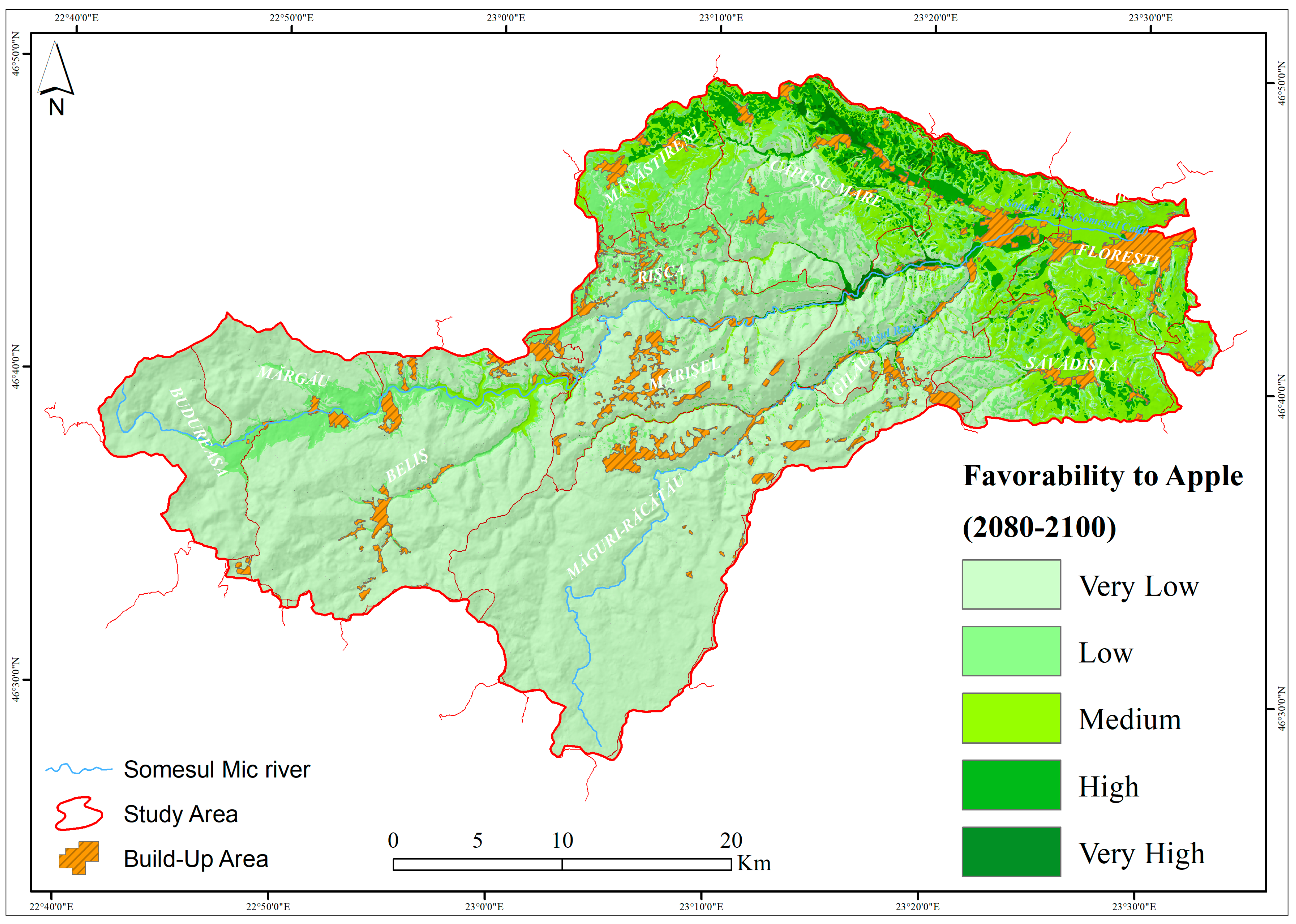
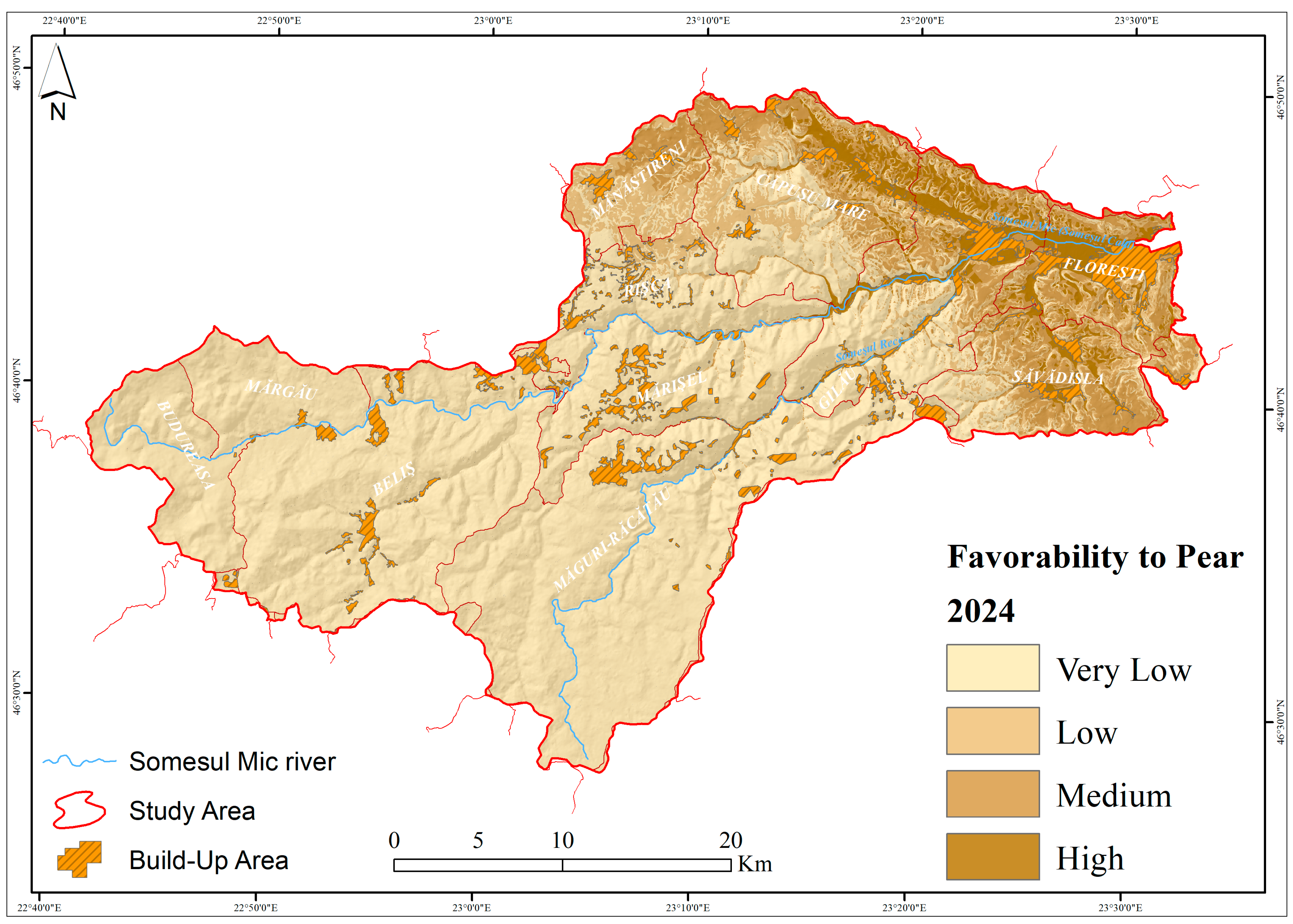

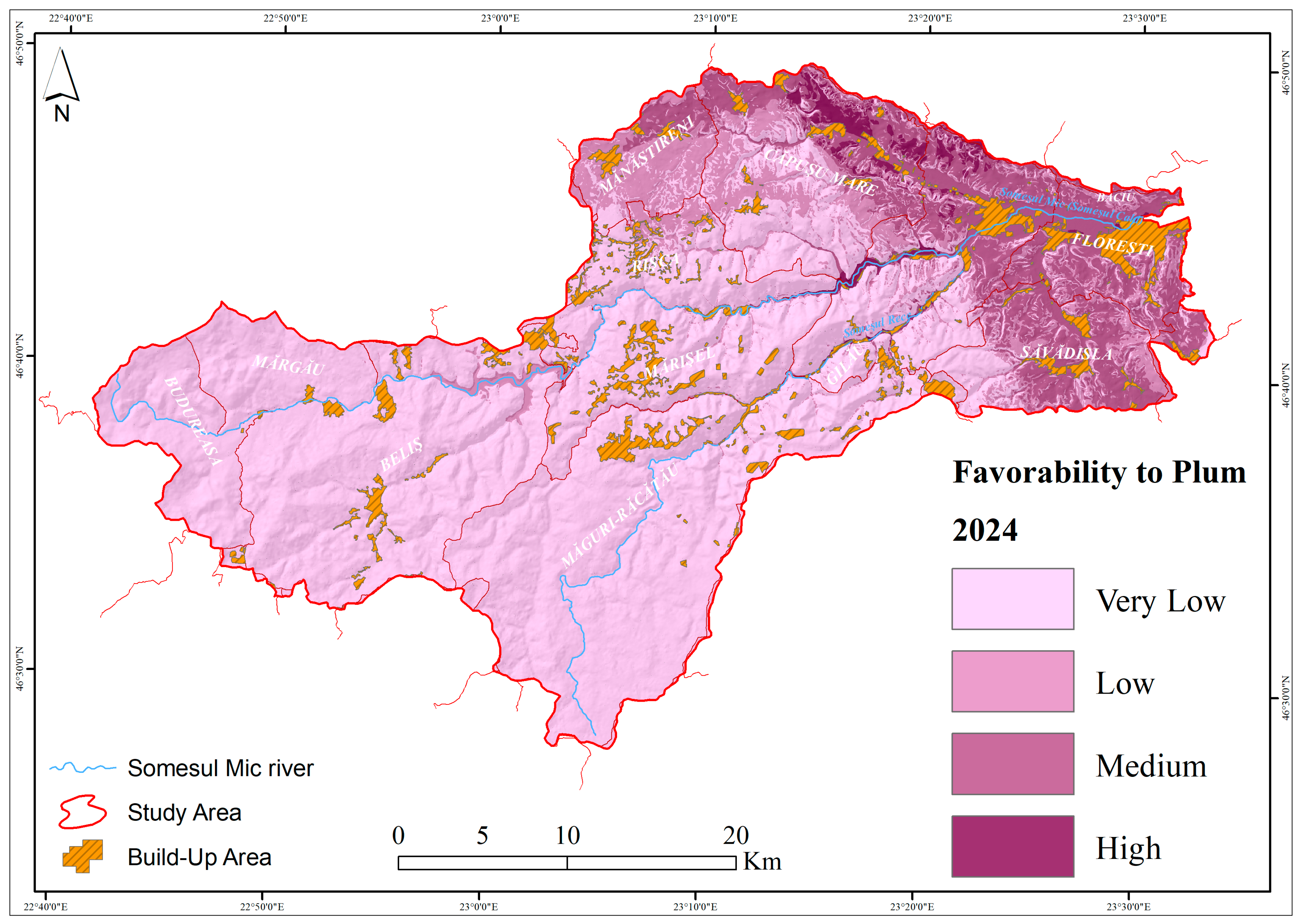
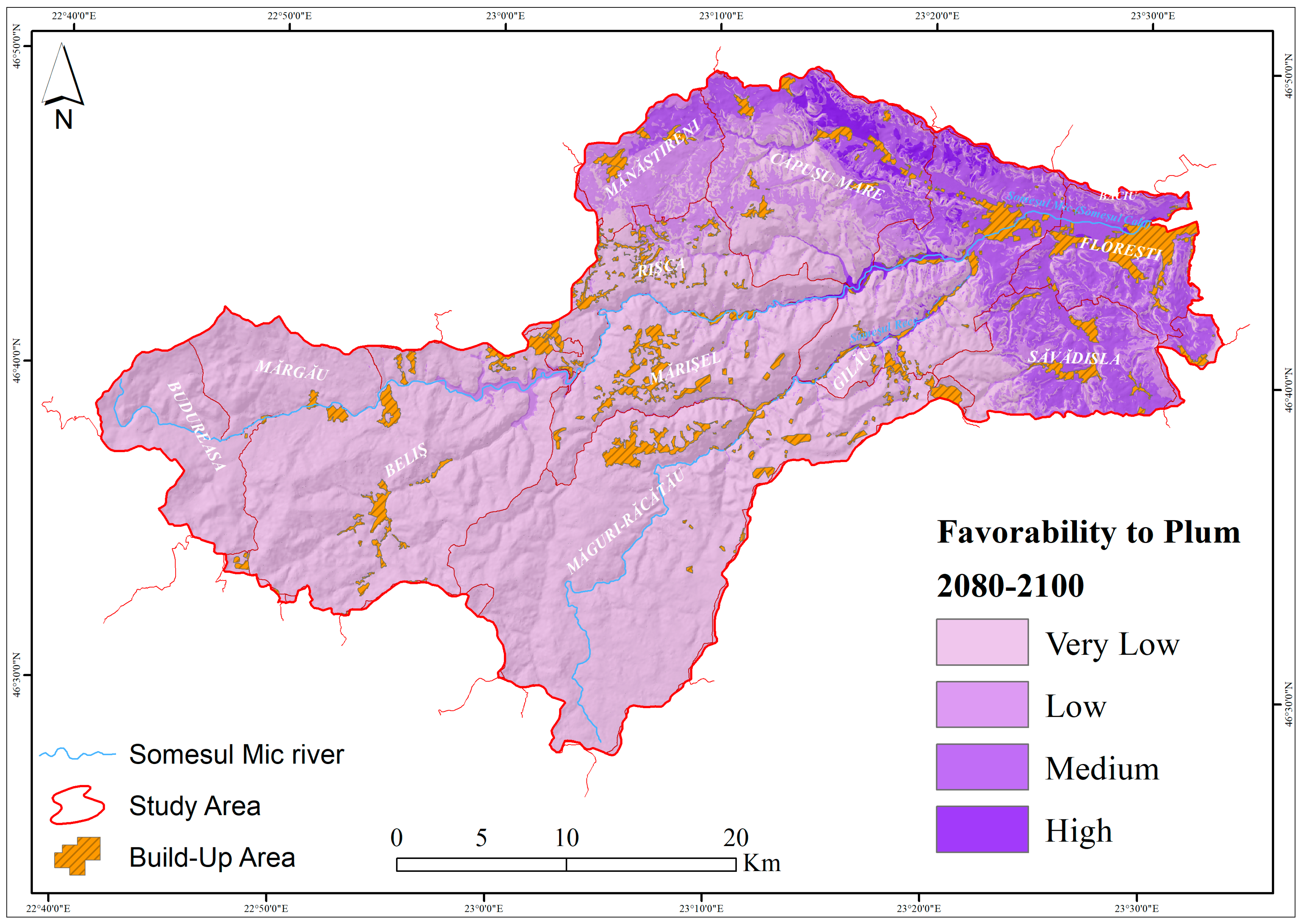

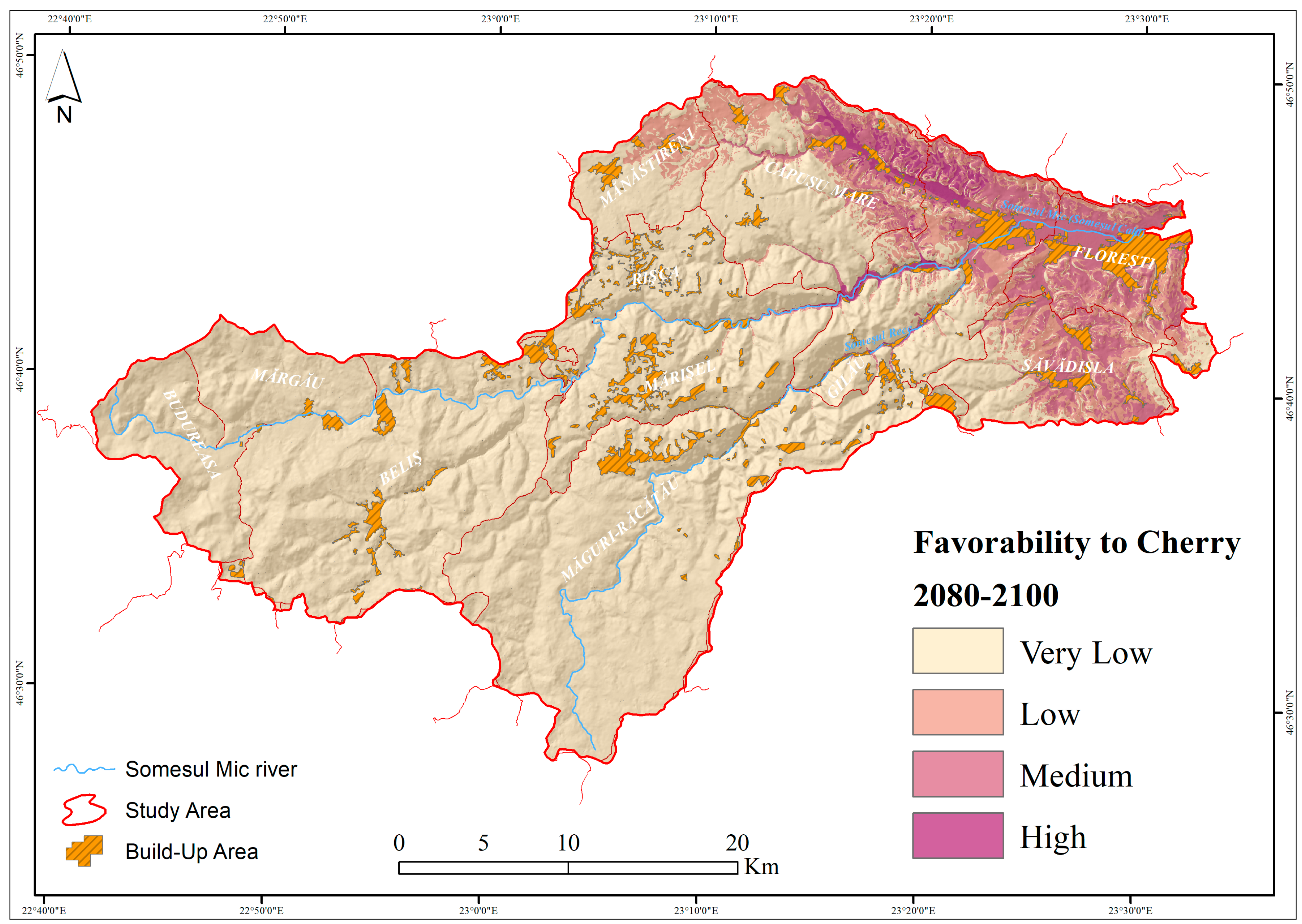
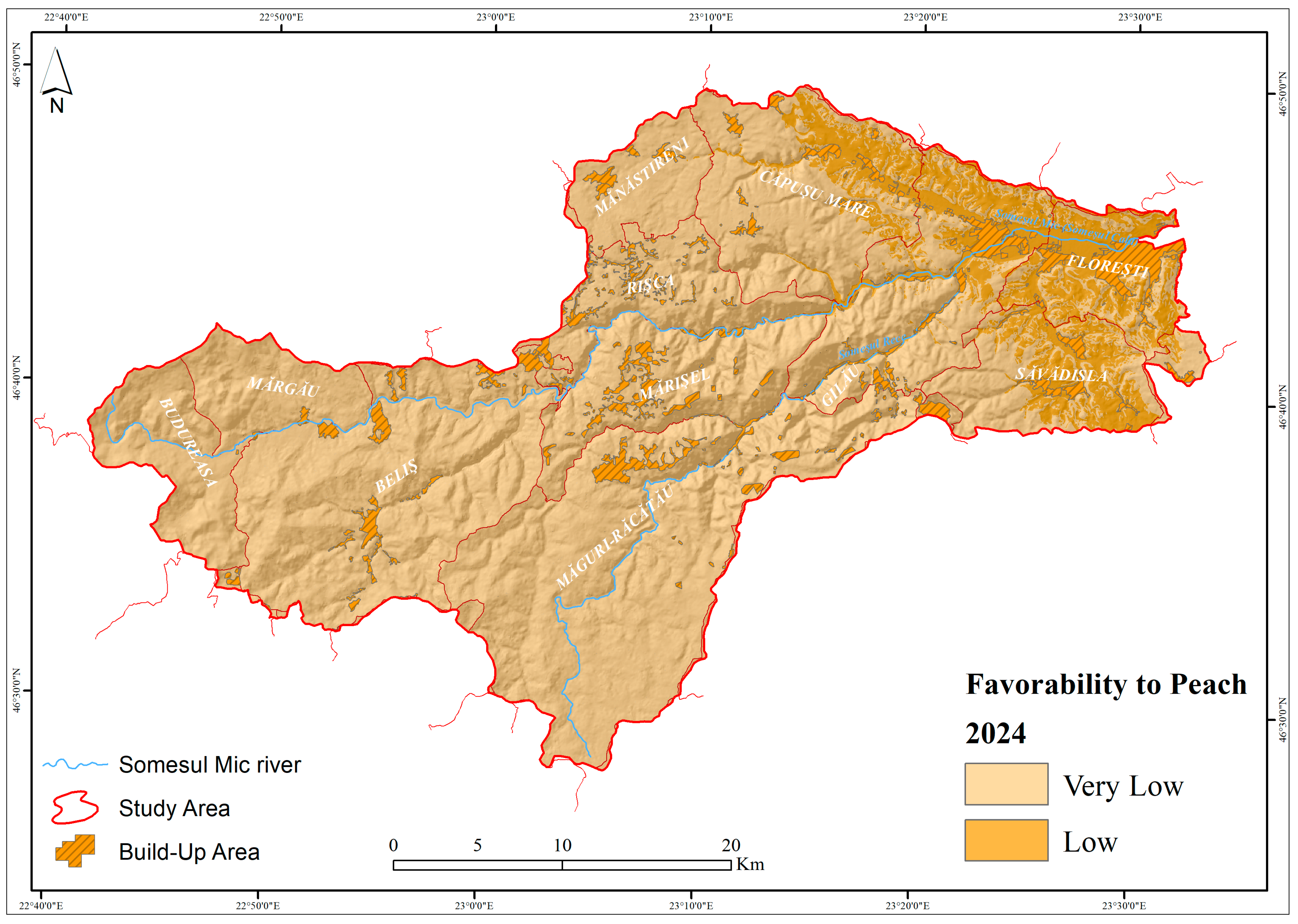
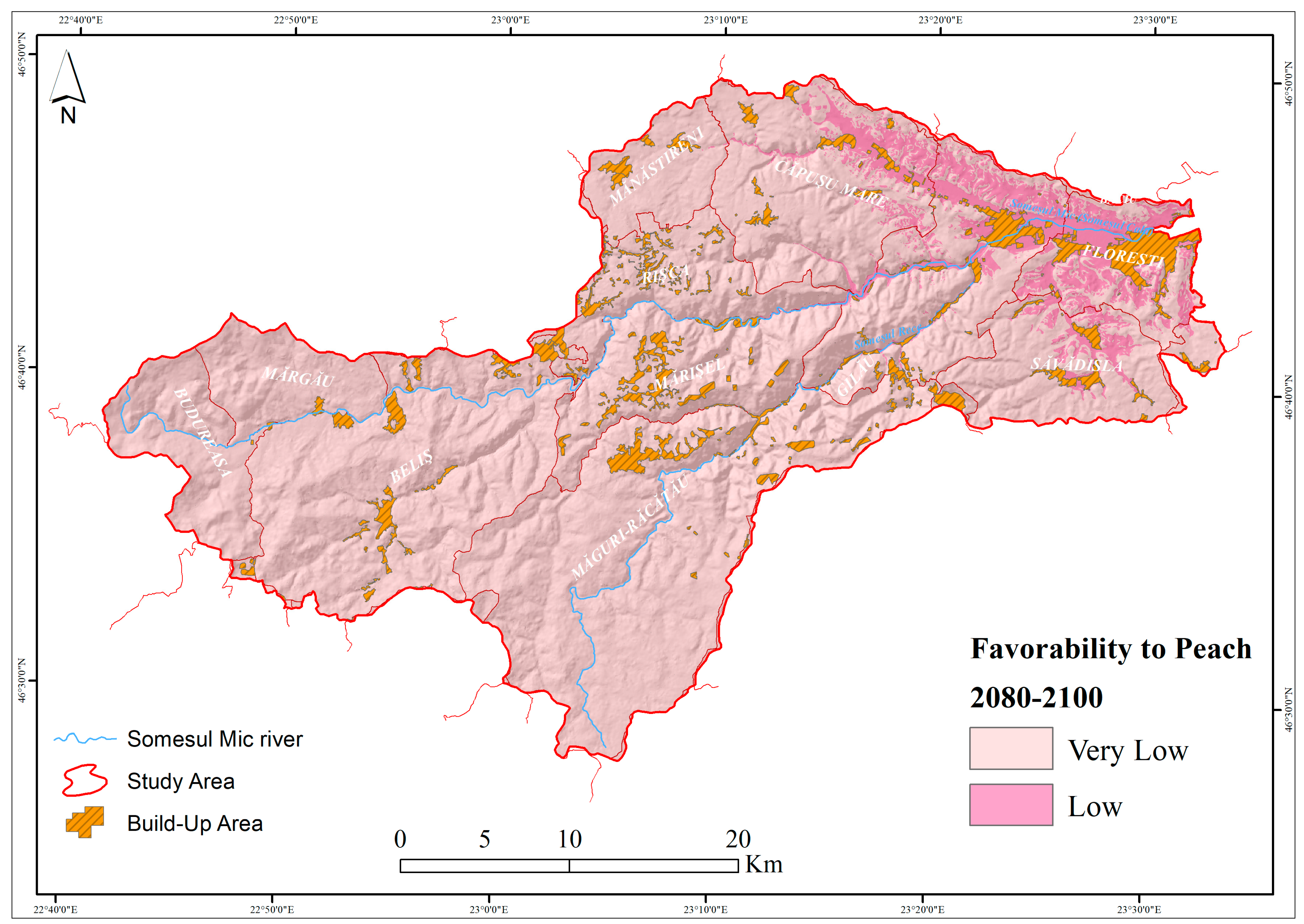

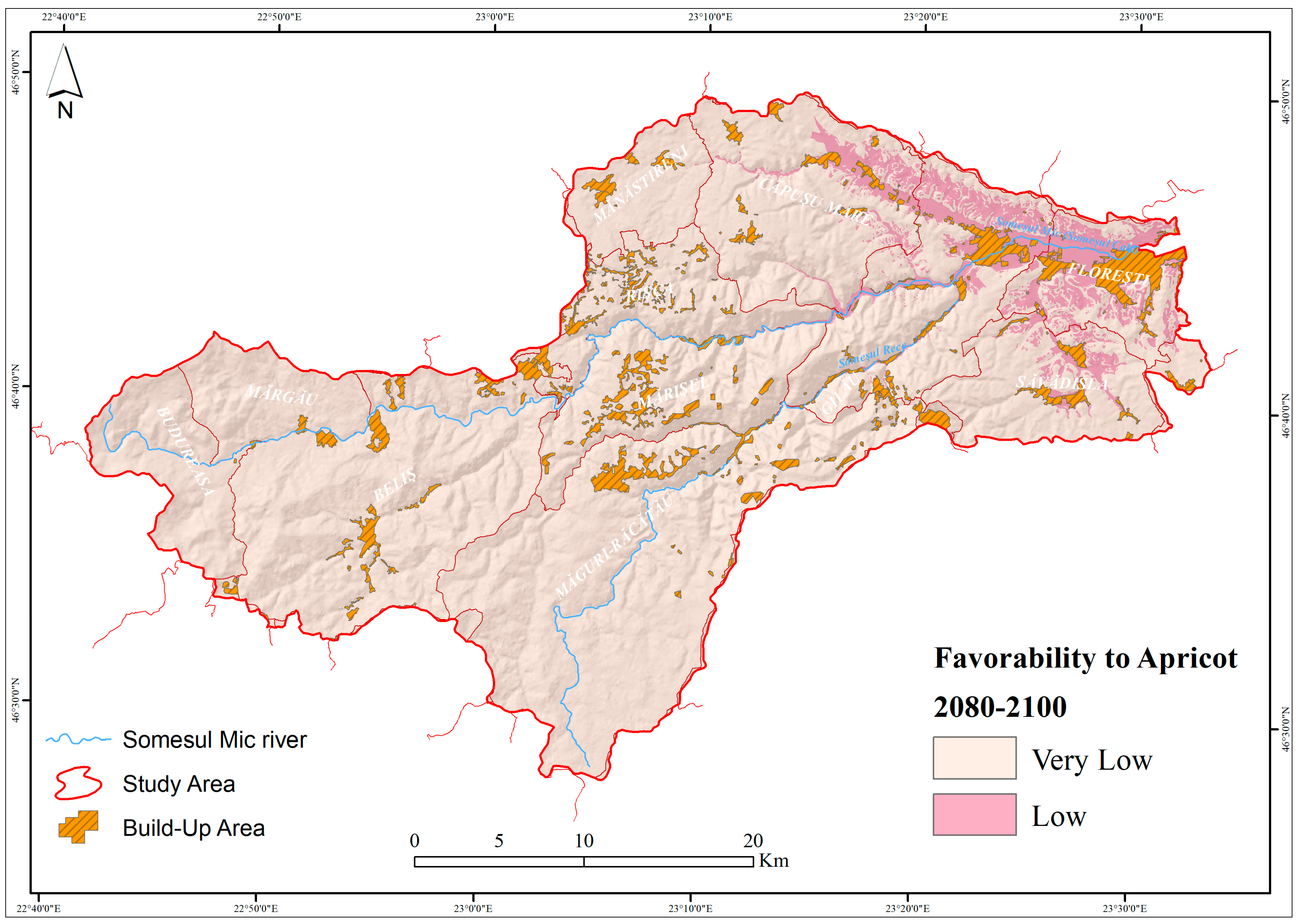
| Dataset | Type/Resolutions | Source |
|---|---|---|
| Romania soils map/type of soil/glazing/stagnogenization/useful edaphic volume | vector | Development for Pedology, Agrochemistry, and Environmental Protection [72] |
| Digital surface model (EU-DEM) | Raster/25 m | Copernicus Land Monitoring Service [73] |
| CORINE Land Cover (CLC 2012) | vector | Copernicus Land Monitoring Service [73] |
| Hansen Global Forest Change | Raster/30 m | Global Forest Change [74] |
| European Settlement Map | Vector | Copernicus Land Monitoring Service [75] |
| European catchments and rivers network system (ECRINS—dams on rivers) | Vector | European Environment Agency [73] |
| Roads and railways | vector | Open Street Map [76] |
| EU-Hydro—River Network | vector | Copernicus Land Monitoring Service [73] |
| Slope | Raster/25 m | Derived from DEM |
| Aspect | Raster/25 m | Derived from DEM |
| Grid of precipitation | Raster/25 m | Modelated |
| Grid of temperature | Raster/25 m | Modelated |
| Landslide probability | Raster/25 m | Modelated |
| Shared Socio-Economic Pathways (SSPs) | Numerical data | The Climate Change Knowledge Portal (CCKP) [77] |
| Favorability to grassland | ||||||||||
| Very Low | Low | Medium | High | Very High | ||||||
| Score/Factors | 0.1 | 0.2 | 0.3 | 0.4 | 0.5 | 0.6 | 0.7 | 0.8 | 0.9 | 1 |
| Slope | >100.0% | 50.1–100.0% | 25.1–35.0% 35.1–50.0% | 20.1–25.0% | 15.0–20.0% | 10.1–15.0% | <2.0; 2.1–5.0; 5.1–10.0% | |||
| Gleization | complete | excessive | very powerful | non-gleizat, weak, moderate, strongly gleizat | ||||||
| Pseudogenization | <0.50 | >3.01 | 0.51–3.00; coastal springs | |||||||
| Soil texture | sand, coarse sand, medium sand, fine sand | silty sand, coarse silty sand, medium silty sand, fine silty sand | medium clay, fine clay | medium textures, sandy loam, coarse sandy loam, medium sandy loam, fine sandy loam, fine sandy loam, dusty sandy loam, dust | sandy loam, medium loam, medium loam, dusty loam, fine textures, clay loam, sandy loam, medium loam, medium clay loam, clay loam, clay, clay loam, clay clay, clay loam, dusty clay, medium clay, fine clay | |||||
| Soil edaphic value | <0.10 | 0.11–0.20 | 0.21–0.50 | >0.51 | ||||||
| Soil reaction | <3.5 | 3.6–4.3 | 4.4–5.8 | 5.5–5.8 | >5.9 | |||||
| Landslides | shallow landslides | |||||||||
| Soil pollution | excessively polluted | very heavily polluted | heavily polluted | moderately polluted | unpolluted, slightly polluted | |||||
| Temperature | <−2.0 °C | −1.9–0.0 °C | 0.1–2.0 °C | 2.1–4.0 °C | 4.1–5.0 °C | 5.1–6.0; >12.0 °C | 6.1–12.0 °C | |||
| Precipitation (mm/year) | <300; >1401 | 301–450; 1201–1400 | 451–500; 501–550; 1001–1200 | 551–600; 600–1000 | ||||||
| Favorability to pasture | ||||||||||
| Very Low | Low | Medium | High | Very High | ||||||
| Score/Factors | 0.1 | 0.2 | 0.3 | 0.4 | 0.5 | 0.6 | 0.7 | 0.8 | 0.9 | 1 |
| Slope | >100.0 | 50.1–100.0 | 35.1–50.0 | 25.1–35.0 | 20.1–25.0 | 15.0–20.0 | <15.0 | |||
| Gleization | complete | excessive | very powerful | non-gleizat, weak, moderate, strongly gleizat | ||||||
| Pseudogenization | <0.50 | >3.01 | 0.51–3.00; coastal springs | |||||||
| Soil texture | sand, coarse sand, medium sand, fine sand | silty sand, coarse silty sand, medium silty sand, fine silty sand | medium clay, fine clay | medium textures, sandy loam, coarse sandy loam, medium sandy loam, fine sandy loam, fine sandy loam, dusty sandy loam, dust | sandy loam, medium loam, medium loam, dusty loam, fine textures, clay loam, sandy loam, medium loam, medium clay loam, clay loam, clay, clay loam, clay clay, clay loam, dusty clay, medium clay, fine clay | |||||
| Soil edaphic value | <0.10 | 0.11–0.20 | 0.21–0.50 | >0.51 | ||||||
| Soil reaction | <3.5 | 3.6–4.3 | 4.4–5.8 | 5.5–5.8 | >5.9 | |||||
| Landslides | shallow landslides | |||||||||
| Soil pollution | excessively polluted | very heavily polluted | heavily polluted | moderately polluted | unpolluted, slightly polluted | |||||
| Temperature | <−2.0 | −1.9–0.0 | 0.1–2.0 | 2.1–4.0 | 4.1–6.0; >12.0 °C | 6.1–12.0 °C | ||||
| Precipitation | <300 | 301–450; >1401 | 451–550; 1001–1400 | 551–1000; | ||||||
| … | ||||||||||
| Favorability | ||||||||||
|---|---|---|---|---|---|---|---|---|---|---|
| Very Low | Low | Medium | High | Very High | ||||||
| Score/ Temperature | 0.1 | 0.2 | 0.3 | 0.4 | 0.5 | 0.6 | 0.7 | 0.8 | 0.9 | 1 |
| Pasture Actual | <−2.0 | −1.9–0.0 | 0.1–2.0 | 2.1–4.0 | 4.1–5.0 5.1–6.0; >12.0 °C | 6.1–12.0 °C 6.1–12.0; | ||||
| Grassland | <−2.0 | −1.9–0.0 | 0.1–2.0 | 2.1–4.0 | 4.1–5.0 | 5.1–6.0; >12.0 | 6.1–12.0; | |||
| Apple trees | <−2.0- | 2.1–4.0 | 4.1–5.0 | 5.1–6.0 | 6.1–7.0 | 7.1–8.0; 11.1–12.0 | 9.1–11.0 | |||
| Brush trees | <−2.0; 4.1–5.0 | 5.1–6.0 | 6.1–7.0 | 7.1–8.0; >11.1 | 8.1–9.0 | 9.1–11.0 | ||||
| Plum trees | <−2.0; 4.1–5.0 | 5.1–6.0 | 6.1–7.0 | 7.1–8.0; >12.0 | 8.1–9.0; 11.1–12.0 | 9.1–11.0 | ||||
| Cherry trees | <−2.0; 4.1–5.0 | 5.1–6.0 | 6.1–7.0 | 7.1–8.0 | >12.0 | 8.1–9.0; >12.0 | 11.1–12.0 | 9.1–11.0 | ||
| Apricot trees | <−2.0; 6.1–7.0 | 7.1–8.0 | 8.1–9.0 | >9.1 | ||||||
| Peach trees | <−2.0; 5.1–7.0; | 7.1–8.0 | 8.1–9.0 | 9.1–10.0 | >10.1 | |||||
| Precipitation (mm/year) | ||||||||||
| Pasture | <300 | 301–400; 401–500; >1401 | 451–550; 1001–1400 | 551–1000 | ||||||
| Grassland | <300; >1401 | 301–400; 401–450; 1201–1400 | 451–550; 1001–1200 | 551–1000 | ||||||
| Apple trees | >1401 | 1201–1400 | <300 | 301–400; | 401–450 | 451–500; 1001–1200 | 501–550; 801–1000 | 551–800 | ||
| Brush trees | >1401 | 1201–1400 | <300; 1001–1200 | 301–400 | 801–1000 | 401–450 | 451–500; 701–800 | 451–700 | ||
| Plum trees | >1401 | 1201–1400 | 1001–1200 | <300 | 301–400; 801–1000 | 701–800 | 401–500 | 501–700 | ||
| Cherry trees | >1401 | 1201–1400 | 1001–1200 | 801–1000 | <300 | 301–400 | 401–450; 701–800 | 451–500; 601–700 | 501–600 | |
| Apricot trees | >1401 | 1001–1200 | 801–1000 | <300; 701–800 | 301–400 | 601–700 | 401–450 | 451–600 | ||
| Peach trees | >1401 | 1001–1200 | 801–1000 | <300 | 301–400; 701–800 | 401–450; 601–700 | 451–500 | 501–600 | ||
| 0.1 | 0.2 | 0.3 | 0.4 | 0.5 | 0.6 | 0.7 | 0.8 | 0.9 | 1 | |
| Period | SSP1-1.9 | SSP1-2.6 | SSP2-4.5 | SSP3-7.0 | SSP5-8.5 |
|---|---|---|---|---|---|
| PP/Y 2020–2039 | 915.96 | 936.95 | 918.78 | 913.83 | 896.5 |
| PP/Y 2040–2059 | 899.96 | 907.79 | 896.93 | 896.91 | 872.03 |
| PP/Y 2060–2079 | 900.91 | 919.22 | 907.7 | 864.65 | 829.7 |
| PP/Y 2070–2099 | 901.06 | 912.06 | 895.02 | 844.22 | 821.94 |
| Period | SSP1-1.9 | SSP1-2.6 | SSP2-4.5 | SSP3-7.0 | SSP5-8.5 |
|---|---|---|---|---|---|
| AvgT 2020–2039 | 10.987 | 11.073 | 11.135 | 10.993 | 11.311 |
| AvgT 2040–2059 | 11.272 | 11.588 | 11.757 | 11.977 | 12.443 |
| AvgT 2060–2079 | 11.134 | 11.748 | 12.341 | 12.995 | 13.808 |
| AvgT 2070–2099 | 10.983 | 11.679 | 12.750 | 14.057 | 15.408 |
Disclaimer/Publisher’s Note: The statements, opinions and data contained in all publications are solely those of the individual author(s) and contributor(s) and not of MDPI and/or the editor(s). MDPI and/or the editor(s) disclaim responsibility for any injury to people or property resulting from any ideas, methods, instructions or products referred to in the content. |
© 2024 by the authors. Licensee MDPI, Basel, Switzerland. This article is an open access article distributed under the terms and conditions of the Creative Commons Attribution (CC BY) license (https://creativecommons.org/licenses/by/4.0/).
Share and Cite
Săvan, G.; Păcurar, I.; Roșca, S.; Megyesi, H.; Fodorean, I.; Bilașco, Ș.; Negrușier, C.; Bara, L.V.; Filipov, F. GIS-Based Agricultural Land Use Favorability Assessment in the Context of Climate Change: A Case Study of the Apuseni Mountains. Appl. Sci. 2024, 14, 8348. https://doi.org/10.3390/app14188348
Săvan G, Păcurar I, Roșca S, Megyesi H, Fodorean I, Bilașco Ș, Negrușier C, Bara LV, Filipov F. GIS-Based Agricultural Land Use Favorability Assessment in the Context of Climate Change: A Case Study of the Apuseni Mountains. Applied Sciences. 2024; 14(18):8348. https://doi.org/10.3390/app14188348
Chicago/Turabian StyleSăvan, Gabriela, Ioan Păcurar, Sanda Roșca, Hilda Megyesi, Ioan Fodorean, Ștefan Bilașco, Cornel Negrușier, Lucian Vasile Bara, and Fiodor Filipov. 2024. "GIS-Based Agricultural Land Use Favorability Assessment in the Context of Climate Change: A Case Study of the Apuseni Mountains" Applied Sciences 14, no. 18: 8348. https://doi.org/10.3390/app14188348








